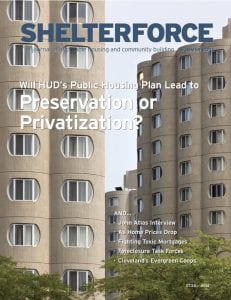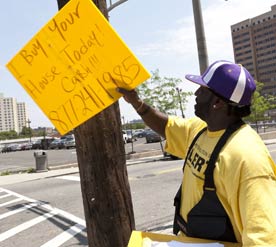
When President Obama was elected, and then selected Shaun Donovan as his HUD secretary, public housing advocates like myself breathed a sigh of relief. Finally, there would be leadership at HUD committed to preserving the stock and not dismantling it. Secretary Donovan’s background in affordable housing development boded well for the future of public housing. With new leadership in place and a new emphasis on preservation—including one-for-one replacement—I was eager to learn how the department planned to preserve public housing into the 21st century.
The resulting plan—PETRA—is well intentioned but has several fatal flaws. First, the plan is heavily dependent upon private capital, with the administration expressly declining to request the $20 to $30 billion in appropriations needed to fill the backlog of capital repairs. It troubles me that we can find over $1 trillion to pay for wars without end in Iraq and Afghanistan and $700 billion to bail out Wall Street. But when it comes to housing for the nation’s poor, the federal government is unable—or unwilling—to meet its commitments.
The over-reliance on private capital also means that public housing could potentially be privatized. I know that the secretary intends for the housing to remain public, and for the use and lease restrictions to remain in place, regardless of whether or not a housing authority has received a loan from a private source. However, the real risk from private capital comes from foreclosure.
While the draft legislation intends for the use restriction to survive foreclosure, HUD seems to want to give itself the ability to waive that requirement in order to “increase lender participation.” I understand the position that department policymakers are in: if the requirements are too strict, no one will participate; if they are too loose, the housing will be lost. However, I fear that in attempting to strike this balance, the current legislation does more harm than good.
Second, the plan lacks a true one-for-one replacement requirement, instead allowing for 50 percent of public housing units to be vouchered out in areas with an “excess supply of affordable housing.” I don’t believe that any area in our country has an excess supply of affordable housing, especially given the current economy. But even if such areas do exist, an excess supply of affordable housing doesn’t mean that that housing is accessible to, or appropriate for, public housing residents.
Public housing serves a population of “hard to house” people who have certain challenges that prohibit them from renting a unit in the private rental market. Without public housing, those persons will be locked out of that market and at risk for homelessness. I don’t understand why a program that is designed to preserve public housing explicitly allows for the diminution of that housing.
Third, while I commend the secretary for his commitment to extend mobility rights to all persons in public and assisted housing, I am concerned about some aspects of the proposed policy. Currently, residents with project-based vouchers can move with their voucher after a year. PETRA proposes allowing all residents to move after two years, yet provides no funding for the incremental tenant-based vouchers that would be needed to fund such moves. I believe that if we are going to have mobility in these programs it should be true mobility. The current proposal appears to pay lip service to mobility—establishing a right but not funding it.
While PETRA is flawed, it is also the only serious attempt any administration has made to preserve public housing in quite some time. As such, it presents us with the opportunity to examine the challenges faced by public housing that I’ve raised for years, and to debate various options to solve those challenges. However, given the precarious state of the nation’s public housing stock, moving forward on these proposals without properly addressing these issues could be more harmful than doing nothing.






Comments